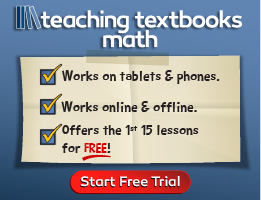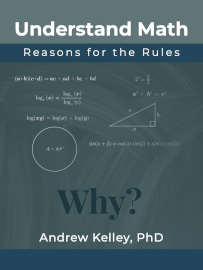The hardcover book Understand Math: Reasons for the Rules can be used as a supplement for most math courses from about sixth grade through high school (and beyond). It should be especially useful alongside courses like those from Saxon Math that do not offer strong conceptual explanations.
Author Andrew Kelley’s goal is to help students truly understand math. He shows the reasons behind the way math works in a practical manner rather than with heady theory. He says, “For most rules, I do not give rigorous proofs. Rather I instead focus on the essence for why the rules work. I focus on the heart of why they are true” (p. i).
While a high school senior or college student might work through most of the book as a refresher, most students will study topics selectively. Younger students need to have been introduced to fractions and variables at least, but sixth or seventh grade is when students are likely to benefit from this book.
The book has 355 pages, and its 12 chapters are titled:
- Fractions
- Pre-algebra
- Arithmetic
- Algebra
- Geometry
- Logic
- Trigonometry
- Complex numbers
- Probability
- Precalculus
- Calculus
- What is Mathematics?
Under each chapter heading, Kelley teaches only concepts he believes lead to a foundational understanding or are particularly troublesome. For example, in the chapter on fractions, he teaches addition, multiplication, and division with fractions, concentrating heavily on what to do with numerators and denominators in each case, since that is probably the most confusing aspect.
Kelley often restates key points students need to know before discussing new topics. For instance, Chapter 5: Geometry begins with the Pythagorean Theorem. Kelley begins by saying, “Recall that a right triangle is a triangle with a 90° angle in it (which is called a right angle), and the hypotenuse is the longest side of a right triangle, the side opposite the right angle.” Then he presents the Pythagorean Theorem and walks students through geometric figures and equations that visually prove why it works.
How It Works
Each topic begins with instruction, although it is sometimes prefaced by a key question in a gray box. Key Questions and Key Facts (also in gray boxes) scattered through the chapters help focus student attention. For instance, after presenting the Key Fact 2.46 on page 33 that defines the distributive property, Key Question 2.47 asks, “Why does x (y + z) = xy + xz.” The following two and a half pages explain why, using several examples and two exercise problems. The examples are often presented as “motivations,” questions that help students think through the concept. The first motivation for the distributive property uses a rectangle to visually help students answer, “If a rectangle has sides of length w and h (the width and the height), then what is its area?” Kelley asks students to try to answer the motivations on their own, but he fully explains each one, often presenting a series of questions to help students think it through. This process is the same as that used by excellent teachers interacting with students to help them develop understanding.
Lessons have more motivations than exercises, and the exercises are typically a single problem to solve that mirrors what students have just learned. Occasional “challenges”
present optional problems for students who want to push beyond essential understanding. Full explanations of the correct answers follow immediately after each motivation, exercise, and challenge, with rare exceptions. There’s no need to flip to a separate answer key. (The only exception I spotted was a challenge on page 297 that asks students to “Use the definition of the derivative to prove Key Fact 11.39,” and then it directs students to “consult any standard calculus textbook” to check their answer.) Students might want to work with a sheet of paper covering the following text to alleviate the temptation to look ahead at the solutions.
What It Covers
The chapters on fractions, pre-algebra, and arithmetic cover topics critical for understanding algebra. After teaching how to understand and work with fractions in the first chapter, Kelley addresses variables, the order of operations, solving simple equations, working with exponents, distributing, factoring, and graphing lines under pre-algebra. Under arithmetic, he addresses the decimal system, forms of multiplication, division by 0, and negative numbers. You can see that these are selective topics under each heading—those likely to be the most troublesome. Kelley occasionally throws in optional bonus topics that are interesting and helpful but not critical for the next step. For instance, in the Arithmetic chapter, two bonus topics are “remainders and divisibility rules for 3 and 9” and “binary numbers.”
At 64 pages, the Algebra chapter is the lengthiest, covering challenging topics such as roots, functions, factoring and quadratics, factoring polynomials, multiple equations with multiple unknowns, inequalities, completing the square, and logarithms. In comparison, geometry has only 12 pages and covers just a few topics, such as the Pythagorean Theorem, working with the fact that angles in a triangle add to 180 degrees, area formulas, and the value of proofs.
The Logic chapter is short and covers just a few basic ideas. Trigonometry covers key elements in 32 pages and teaches an acronym for recalling the formulas for finding the three functions: sine, cosine, and tangent. Twelve pages cover the topic of complex numbers. The chapter on probability reviews basic set theory and then moves beyond that into topics like “Binomial coefficients and probability.” Precalculus explores functions, graphing functions, and a few other selective topics, such as “The sum and difference of cubes and related patterns” and “Product-to-sum trigonometric identities.” The calculus chapter discusses limits, derivatives, integrals, the Fundamental Theorem of Calculus, Limits of indeterminate form, infinite series, and “How fast certain functions approach infinity.”
In Kelley’s introduction to the final chapter, What is Mathematics, he says, “If math really has enormous variety in it, wouldn’t it be sad if a book that includes a broad spectrum of math didn’t also include some really cool stuff that you’ve never seen before?” In answer to that question, he discusses intriguing theorems and curiosities such as the Konigsberg bridge problem, Fermat’s last theorem, arithmetic progressions among primes, and the twin primes conjecture.
And More
For a few topics, Kelley thought he could explain concepts better via video than in the textbook, so he has created seven short videos that are available for free on YouTube. For example, one of them addresses the question, “What happens if you actually divide by 0?”
The index at the back helps students quickly find particular topics.
The author’s Christian worldview comes through subtly in his obvious delight in the beauty and orderliness of mathematics, in a few scripture verses at the beginning of some chapters, in the chapter on logic, and in the book's final paragraph. I don’t think these elements are likely to limit its appeal to any audience.
You can download a generous 60-page free sample from the author's website.










